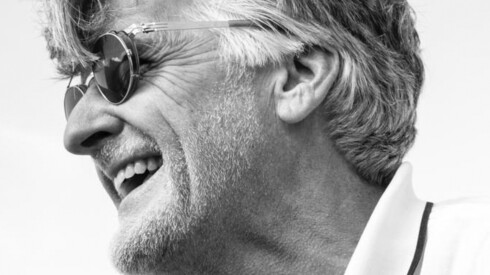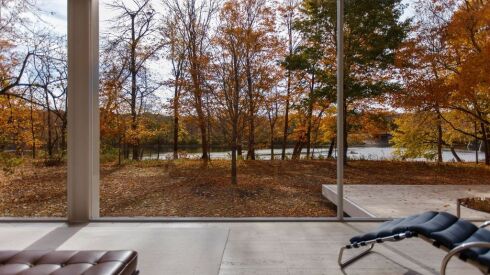Whenever the Edith Farnsworth House is discussed, written about or photographed, the home — a white single-story modernist steel-and-glass pavilion — commands the spotlight.
But the residence is only half the story.
Often overlooked is the beautiful 60-acre Fox River site on which the Mies van der Rohe-designed home sits.
Dr. Edith Farnsworth selected the Plano location for what was built as her weekend home. And a new multimedia exhibition at the house museum — owned by the National Trust for Historic Preservation since 2004 — shows why she was drawn to the site.
Titled “Inhabit: Edith Farnsworth House and Environs in Four Seasons,” the exhibit uses time-lapse photography, video and sound to show the home’s stunning grounds over the course of a year.
The exhibit is the work of architect Tom Rossiter, a retired executive from the design firm AECOM, who is enjoying a successful career as an in-demand architecture photographer.
“I think we all have this fantasy of living in a glass house — this thin veil where we could really experience nature,” Rossiter said. “And I thought, ‘What a rare privilege if I could give that as an offering to people.'”
Nature and the glass house
Rossiter developed Inhabit, which opened last month, during his time as the Farnsworth House’s 2025 Artist in Residence.
To create the show, Rossiter placed cameras inside the Farnsworth, shooting outward through its large windows, and outside the house. Another camera sat across the Fox River and was pointed toward the house.
“How do we describe the experience of being within the glass house, [and] also think about the glass house in the context of nature, from the outside,” Rossiter said.
He used computer software to fire the cameras’ shutters every 20 seconds for 24 hours, during a spring, summer, winter and fall day.
The photos were combined to create still images and a time-lapse movie that gives the sensation of being inside and outside the home as seasons change.
“I am using a lot of technology, but at the end of the day, I want it to appear as if you were sitting in an armchair watching this comfortably from both inside and outside,” Rossiter said.
The results are dreamlike wide-angle images showing the house almost lost in the surrounding landscape, ground, river and sky. The views looking out from inside the Farnsworth are equally mesmerizing, as the home’s large windows frame nature outside.
In a long-exposure image Rossiter captured last fall, streaks of light from star trails, satellites and airplane traffic spin and slash across the night sky above the Farnsworth. Their reflections are caught in the mirror stillness of the Fox River below.
“I wanted people to understand … we think the sky is wild, but the sky is no longer wild,” Rossiter said. “There are hundreds of thousands of satellites orbiting, and so we’re polluting the atmosphere, the same way we’ve polluted the earth.”
And you can feel the cold in a winter photograph taken from inside the home showing denuded trees and snow-covered surroundings — including the whitened-over river.
Rossiter’s photographs of the Fox River and the Farnsworth together were taken from the nearby Silver Springs State Fish and Wildlife Area.
As he photographed the scenes in winter, Rossiter said he endured foot-deep snow. He also got acquainted with the park’s wildlife.
“They didn’t want me to put a tent up, which means I had to sleep in a vehicle or just on the ground,” he said. “I wouldn’t have gotten to know the owl that lives in the [park], unless I camped there and sat there.”
Beyond Mies
The crew at the Farnsworth House has done an admirable job bringing in events and exhibits that have expanded interpretation of the home beyond the simple “Mies designed this masterpiece” narrative.
The house, 60 miles southwest of Chicago, has hosted lectures and art installations, while also delving into the remarkable life of its original owner Farnsworth, a nephrologist, or doctor specializing in kidney conditions, and musician.
Farnsworth House Executive Director Scott Mehaffey said the organization in 2024 began focusing on the land surrounding the home.
“Mies wrote about this,” Mehaffey said. “About keeping the interior of the house neutral because the show is all around you, [having] nothing to distract or detract from nature.”
“We thought of Tom right away because of his photography and the fact that he has a career that balances architectural photography and the relationship of architecture to the site,” he said.
In addition to photographs and video, Inhabit features recorded Native American music and various sounds Rossiter captured while creating the exhibition.
“[The Farnsworth House] is really most often photographed as a work of art — a work of architecture — devoid of its interrelationships with nature and the seasons,” Mehaffey said. “Tom intervenes with that typical interpretation and reconnects it to the site.”
INHABIT is open until Nov. 23. The Edith Farnsworth House is located at 14520 River Road, Plano.

